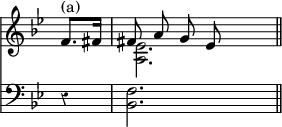cipe, or president, in 1725, 29, 45, 47, and 50. In 1729 he came to England and sang, with Bernacchi, his fellow-pupil under Pistocchi, in Handel's 'Tolomeo,' taking the part of Araspe, formerly sung by Boschi. As the latter was a Bass, the part was probably transposed for Fabri for want of a Bass to sing it. In the same year he performed the tenor part in 'Lotario,' as also in 'Partenope' (1730), and in 'Poro' and a reprise of 'Rinaldo' (1731), all by the same master. Having been appointed to the Royal Chapel at Lisbon a few years later, he died there Aug. 12, 1760.
[ J. M. ]
FABRIZZI, Orazia, an Italian prima donna, described by Lord Mount-Edgcumbe as 'very far from a bad singer, but neither young nor pretty, therefore not liked'; she appeared in London about 1796 and sang that year the principal rôles in Martini's 'Consiglio Imprudente' and Cimarosa's 'Traci Amanti,' as also in Martini's 'Arbore di Diana.' She was not re-engaged.
[ J. M. ]
FACKELTANZ, or Marche aux flambeaux, a torchlight procession—a survival from the mediæval tournaments—which takes place at some of the German Courts on occasion of the marriage of members of the royal family. The procession has to march round the court or hall, with various intricate ceremonies (Times, Feb. 19, 1878). The music—for military band—is a Polonaise in march-time (3-4), usually a loud first and last part, and a soft trio. Meyerbeer has written four—one for the marriage of the Princess Royal (Jan. 25, 1858). Spontini, Flotow, and others, have also written them.
[ G. ]
FAGOTTO. The Italian name for the Bassoon, obviously arising from its resemblance to a faggot or bundle of sticks. The Germans have adopted it as Fagott. [See Bassoon.]
[ W. H. S. ]
FAIR ROSAMOND. A grand opera in 4 acts; words by C. Z. Barnett, music by John Barnett; produced at Drury Lane Feb. 28, 1837.
FA-LA. A piece of vocal music for three or more voices, originally set wholly or in part to these two sol-fa syllables. Fa-las belong essentially to the madrigalian era, most of the composers of which have left specimens of them. They are said to be the invention of Gastoldi di Caravaggio—if the utterance of musical sounds on unmeaning syllables can be called an invention. Many of his 'balletti,' like many of the Ballets of Morley—such as 'Now is the month of Maying'—end with a lengthened Fa-la. A 4-part song known as 'The Waitts,' by an English composer Jeremiah Saville, set wholly on those syllables, is probably the most popular Fa-la in existence.
[ J. H. ]
FALLING A BELL. The operation of gradually swinging a bell from the position shown in Fig. 2, p. 219, to that in Fig. 3, p. 220. [See Bells.]
[ C. A. W. T. ]
FALSE RELATION is the occurrence of chromatic contradiction in different parts or voices, either simultaneously, as at (a), or in chords which are so near together that the effect of one has not passed from the mind before the other comes to contradict it with a new accidental, as at (b).

The disagreeable effect is produced by the contradictory accidentals belonging to different keys, or unequivocally to major or minor of the same key; and it follows that when the contradiction is between notes which can coexist in the same key the effect is not disagreeable. Thus chromatic passing notes and appoggiaturas do not affect the key, and are used without consideration of their apparent contradictions. Schumann uses the sharp and natural of the same note in the same chord in his 'Andante und Variationen' for two pianofortes, op. 46 (a), and Haydn the same in his Quartet in D, op. 71 (b).

etc.

etc.
Again, notes which are variable in the minor key do not produce any objectionable effect by their juxtaposition, as the minor 7th descending and the major 7th ascending or stationary; thus Mendelssohn in the Overture to 'Ruy Bias' has B♭ and B♮ in alternate chords.

And the treatment of notes which are inter-changeable in chromatic and diatonic chords in the same key is equally free, as between a chromatic note of the chord of the augmented sixth and a succeeding diatonic discord.

The rule is further modified by so many exceptions that it is almost doubtful if the cases in which the effect is objectionable are not fewer than those in which it is not.
[ C. H. H. P. ]
FALSETTO. The voices of both men and women contain two—or, as defined in the 'Méthode du Chant du Conservatoire de Musique,' three—registers, viz. chest voice (voce di petto); head voice (v. di testa); and a third which, as being forced or non-natural, is called by Italians and French falsetto or fausset, or 'false' voice. The limits of these are by no means fixed. In every voice identical notes can be produced in more ways than one, and thus each register can be extended many degrees beyond its normal

